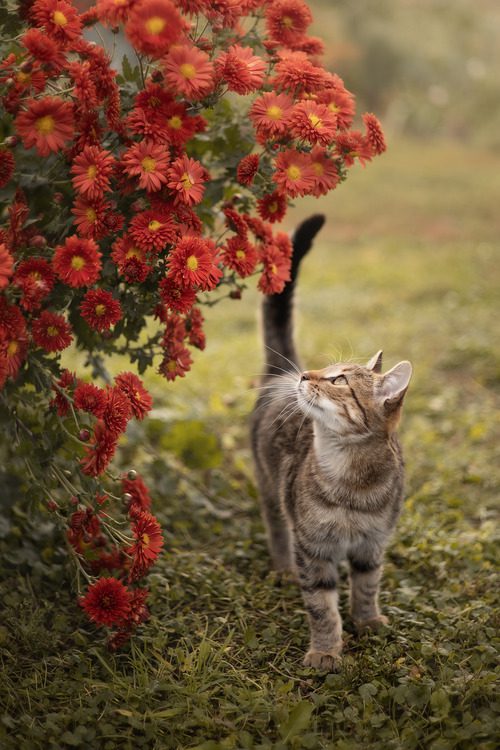Are Chrysanthemums Toxic to Cats?

Chrysanthemums, often known for their vibrant blooms and decorative appeal, are a favorite in many gardens and homes across Texas. However, as a cat owner, you might wonder: Are chrysanthemums toxic to cats? Understanding the potential dangers that certain plants pose to our feline friends is crucial. In this blog, we’ll dive into the toxicity of chrysanthemums to cats and provide essential information for keeping your pets safe. If you suspect your cat has been exposed to chrysanthemums or is exhibiting unusual symptoms, contact Bulverde Animal Hospital immediately at (830) 438-7200.
What Are Chrysanthemums?
Chrysanthemums, commonly referred to as mums, are flowering plants widely cultivated for their beauty and versatility. Native to Asia and Northeastern Europe, these flowers come in various shapes and colors, adding life and vibrancy to gardens and floral arrangements. Despite their allure, chrysanthemums can pose significant risks to curious cats who nibble on their leaves and blooms.
Why Are Chrysanthemums Toxic to Cats?
Chrysanthemums contain several toxic compounds, including pyrethrins, sesquiterpene lactones, and other essential oils. These substances can be extremely harmful to cats, even in small quantities. The following compounds are the primary culprits:
- Pyrethrins: Insecticidal compounds that are highly toxic to cats. They can cause neurological and gastrointestinal issues.
- Sesquiterpene Lactones: Bitter compounds that can lead to skin irritation and digestive problems in cats.
- Essential Oils: Volatile compounds that contribute to the distinctive scent of chrysanthemums and can cause drooling, vomiting, and other symptoms in cats.
Symptoms of Chrysanthemum Poisoning in Cats
Recognizing the symptoms of chrysanthemum poisoning is vital for prompt veterinary intervention. If your cat has ingested any part of the chrysanthemum plant or comes into contact with its sap, you may notice the following symptoms:
- Drooling
- Vomiting
- Diarrhea
- Loss of appetite
- Incoordination (ataxia)
- Skin irritation (from direct contact)
- Lethargy
- Depression
- Seizures (in severe cases)
If your cat is showing any of these symptoms, particularly after being near chrysanthemums, it’s important to seek immediate veterinary care.
How Veterinarians Treat Chrysanthemum Poisoning
While it’s essential to recognize the symptoms early, professional veterinary care is crucial for treating chrysanthemum poisoning effectively. Here’s a look at the general treatment process:
Diagnosing Chrysanthemum Toxicity
Diagnosis is primarily based on the symptoms exhibited and a history of exposure to chrysanthemums. Your veterinarian may perform blood tests, urinalysis, and a physical examination to determine the severity of the poisoning and the best course of treatment.
Initial Examination
The veterinarian will first assess your cat’s condition, asking about potential exposure to chrysanthemums and observing the exhibited symptoms. This initial examination helps determine the severity of the poisoning.
Inducing Vomiting
If the ingestion occurred recently, the veterinarian may induce vomiting to remove any remaining plant material from the stomach. This step is followed by administering activated charcoal to prevent further absorption of toxins.
Supportive Care
Supportive care is essential for stabilizing your cat and managing symptoms. This can include:
- Intravenous fluids to prevent dehydration and flush toxins from the body.
- Medications to control vomiting, diarrhea, or seizures if they occur.
- Continuous monitoring of your cat’s condition to adjust treatment as needed.
Preventing Chrysanthemum Poisoning in Cats
Prevention is always better than treatment, so consider these steps to keep your cat safe:
- Avoid Planting Chrysanthemums: If your cat roams freely outdoors, avoid planting chrysanthemums in your garden or yard.
- Limit Access to Flowers: Keep any bouquets or floral arrangements containing chrysanthemums out of your cat’s reach.
- Provide Cat-Safe Alternatives: Offer cat-friendly plants like catnip or cat grass to satisfy your pet’s curiosity.
- Educate Family and Friends: Inform your family and friends about the risks of chrysanthemums to cats to prevent accidental exposure.
Cat-Safe Plants to Consider
Instead of chrysanthemums, consider these cat-safe alternatives for your garden or home:
- Spider Plant
- Boston Fern
- Areca Palm
- Baby’s Tears
- Parlor Palm
Protecting Your Cat From Toxic Plants
Are chrysanthemums toxic to cats? Yes, they are. Understanding the risks and symptoms associated with chrysanthemum toxicity can help you protect your feline companions. If your cat shows any signs of poisoning or has been exposed to chrysanthemums, contact Bulverde Animal Hospital at (830) 438-7200 for immediate assistance. Keeping your home and garden safe for your pets ensures they can explore their environment worry-free. By being aware of common toxic plants like chrysanthemums and offering safer alternatives, you can help your cat live a healthier, happier life.
Recent Posts
About Us
At Bulverde Animal Hospital, our ultimate goals are excellent service to clients, personal growth, and the professional development of our staff. We are a small clinic creating a significant impact on pets' lives.
